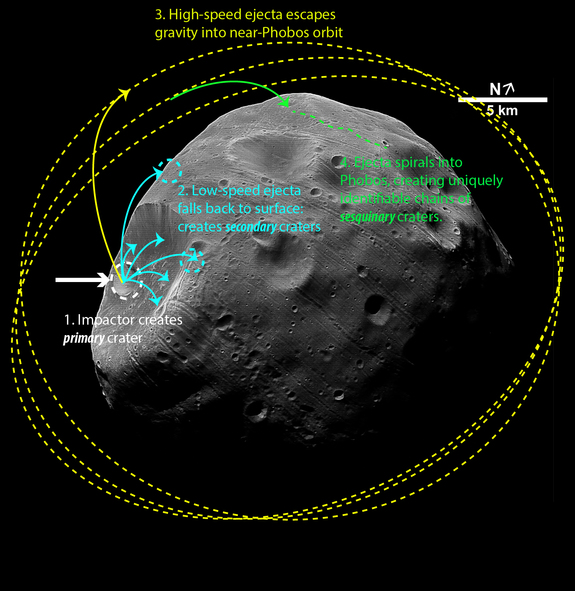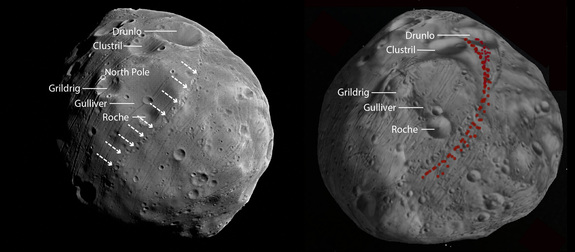Crisscrossed grooves and chains of small craters cover the Martian moon Phobos. Astronomers have disagreed about what caused this strange-looking landscape for decades, but new research may help settle the debate.
Phobos, the largest and closest of Mars’ two moons, is more like a gravitationally bound pile of rubble than a solid, spherical satellite like Earth’s moon. New simulations show that some of the grooves likely came from impactors like asteroids and comets striking the moon, knocking bits and pieces of its surface into space before they landed back onto the surface.
“All this dirt is kicked up, and it falls nearby very ballistically, creating dimples in the surface,” said Michael Nayak, co-author of the new study and graduate student at the University of California, Santa Cruz. “Imagine a golf ball rolling along the sand and it suddenly bounces, leaving a dimple here and a dimple there until at some point it just peters out.” This is how crater chains appeared on Phobos, the study suggests.
First Phobos photos spark debate
NASA’s Viking orbiters first photographed the grooves on Phobos in the 1970s. Since then, astronomers have widely believed that the long, parallel lines seen on the satellite’s surface are “stretch marks” caused by tidal stress from Mars’ gravity,
But later images, from NASA’s Mars Global Surveyor and the European Space Agency’s Mars Express revealed another set of grooves on Phobos that didn’t fit the profile for tide-induced marks. The newfound grooves were smaller and superficial, and they didn’t line up with the moon’s main tidal grooves.
“More detailed imagery started uncovering a second family of grooves, and it turns out that they don’t match the tidal patterns at all,” said Nayak. Astronomers needed another explanation, he said.

Credit: ESA/DLR/FU Berlin-Neukum; Annotations by M. Nayak & E. Asphaug
Simulating impact craters
Nayak as his colleague Erik Asphaug, a planetary scientist at Arizona State University and professor emeritus at UC Santa Cruz, used numerical simulations to determine where these so-called “anomalous grooves” came from. To do this, the researchers simulated collisions on the moon that were responsible for existing craters. Then they modeled the ejecta, or dirt and rocks that are catapulted into space after a collision.
The astronomers’ research suggests that these unexplained lines on Phobos resulted from things in space, called impactors, hitting the satellite and knocking some of its rubble into short-lived orbits.
“Because the gravity on Phobos is so low, ejecta starts escaping the surface,” said Nayak. But this material can’t escape Mars’ gravity, becoming “almost like a new Martian satellite,” Nayak explained. “It doesn’t stray far from Phobos, and it falls back down” after a period of weeks, days — even hours, he said.
“If we model that ejecta, it comes back and hits in this very definitive pattern,” Nayak said.
The researchers modeled several craters on Phobos and found that the models were accurate for many chains of craters, but not all of them. That was expected, though, because, the researchers said, they already suspected that there could be multiple reasons for the existence of these grooves.

Credit: ESA/DLR/FU Berlin-Neukum; Annotations by M. Nayak & E. Asphaug
Debate settled?
Nayak and Asphaug are not the first to suggest that these crater-chain grooves result from secondary impacts. A 2014 study led by John Murray at the Open University in the United Kingdom first hypothesized that ejecta from impacts on Mars caused the grooves.
But this model does not explain all the strange patterns on Phobos, just like the tidal idea didn’t explain the two families of grooves. “Really, it’s a combination of tidal forces … and sesquinary ejecta — the stuff that’s kicked off of Phobos, hangs out in orbit for a while, and then comes back.” Sesquinary craters differ from secondary craters, which occur when a larger, primary impact kicks rubble up a short distance before it quickly falls back down. The rubble that creates sesquinary craters can linger in Mars’ orbit for weeks before plopping back down onto Phobos’ surface.
Nayak said he believes the paper will help tie together some of the existing theories about the origins of Phobos’ grooves. “We don’t really have a good explanation for all the grooves yet,” he said, adding that the surface features of Phobos likely have multiple origins, as no single hypothesis has been able to adequately explain all of the satellite’s grooves and linear craters.
So Phobos can have more than one reason for being so groovy, even if astronomers haven’t figured them all out yet.
Source: Space.com

































Leave a Comment
You must be logged in to post a comment.